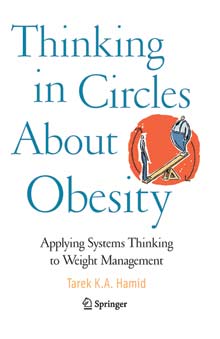Americans know more about food and nutrition than ever, yet obesity is becoming an epidemic. With his new book, Thinking in Circles about Obesity: Applying Systems Thinking to Weight Management, Tarek K. A. Hamid, PhD ‘84, hopes to combat the problem by changing our approach to it. The trick, he says, lies in system dynamics–a method of studying and managing complex feedback systems that was first developed at MIT in the 1950s.

Tarek K. A. Hamid, PhD ’84
Springer, 2009, $27.50
Whether you’re working with a human body or a nuclear reactor, Hamid says, you need to understand how the system works and how it is likely to react to intervention. In the case of weight management, you need to know how your body regulates weight and how variations in routine will affect that weight. “The big idea most people rely on is your body’s wisdom: you eat when you’re hungry and stop when you’re full,” he says. “But that’s not wise–our system is slightly biased to gain weight.” Our hunter-gatherer ancestors were more likely to be malnourished than obese, so humans evolved to eat their fill whenever they had the chance.
Hamid maintains that the “energy balance equation” (the idea that any combination of fewer calories consumed and more calories expended equals weight loss) is too simplistic because it suggests that a given energy deficit will reduce weight by the same amount no matter how it’s achieved. “In reality,” he says, “how an energy deficit is created does matter. Energy, in other words, is not a single currency.”
For example, Hamid says, you could cut 1,000 calories per day by eliminating four cans of beer and a slice of cheesecake from your diet, or by jogging seven miles. “Both these strategies would create the same caloric deficit,” he says. “Over a period of time, however, the patterns of weight change that will result from these two different strategies will be different.” Cutting calories may lead to faster weight loss, but exercise improves the body’s fitness level, helping to maintain its energy requirements at a higher level.
Hamid hopes the models presented in the book will lead to computer-based tools that can help people predict how diet and exercise decisions will affect their weight. A program might allow you to create a virtual twin on your PC that Hamid says would grow or shrink with you. “You give it information about what you are doing and how your body is reacting, and it becomes more and more accurate,” he explains. The virtual twin would help you test out the effects of diet and exercise decisions in advance.
Hamid says Thinking in Circles about Obesity isn’t an attempt to popularize a new weight-loss method; instead, the book’s aim is to “help people realize that in managing their health and their bodies, they are decision makers who are managing a truly complex and dynamic system,” he says. “Effective self-regulation requires more than motivation. It requires understanding and skill. The book helps with both.”
Keep Reading
Most Popular
Large language models can do jaw-dropping things. But nobody knows exactly why.
And that's a problem. Figuring it out is one of the biggest scientific puzzles of our time and a crucial step towards controlling more powerful future models.
The problem with plug-in hybrids? Their drivers.
Plug-in hybrids are often sold as a transition to EVs, but new data from Europe shows we’re still underestimating the emissions they produce.
Google DeepMind’s new generative model makes Super Mario–like games from scratch
Genie learns how to control games by watching hours and hours of video. It could help train next-gen robots too.
How scientists traced a mysterious covid case back to six toilets
When wastewater surveillance turns into a hunt for a single infected individual, the ethics get tricky.
Stay connected
Get the latest updates from
MIT Technology Review
Discover special offers, top stories, upcoming events, and more.